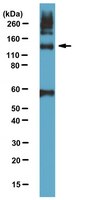07-1431 Sigma-AldrichAnti-Tie-2 Antibody, NT
This Anti-Tie-2 Antibody, N-terminus is validated for use in WB for the detection of Tie-2.
More>> This Anti-Tie-2 Antibody, N-terminus is validated for use in WB for the detection of Tie-2. Less<<Recommended Products
Overview
| Replacement Information |
|---|
Key Spec Table
| Species Reactivity | Key Applications | Host | Format | Antibody Type |
|---|---|---|---|---|
| H, M, R | WB | Rb | Affinity Purified | Polyclonal Antibody |
| References |
|---|
| Product Information | |
|---|---|
| Format | Affinity Purified |
| Control |
|
| Presentation | Affinity purified immunoglobulin. Liquid in 100 mM Tris, pH 7.5, containing 0.2% BSA and 0.05% sodium azide. |
| Quality Level | MQ100 |
| Applications | |
|---|---|
| Application | This Anti-Tie-2 Antibody, N-terminus is validated for use in WB for the detection of Tie-2. |
| Key Applications |
|
| Physicochemical Information |
|---|
| Dimensions |
|---|
| Materials Information |
|---|
| Toxicological Information |
|---|
| Safety Information according to GHS |
|---|
| Safety Information |
|---|
| Storage and Shipping Information | |
|---|---|
| Storage Conditions | Maintain at -20°C in undiluted aliquots for up to 12 months after date of receipt. Avoid repeated freeze/thaw cycles. |
| Packaging Information | |
|---|---|
| Material Size | 50 µg |
| Transport Information |
|---|
| Supplemental Information |
|---|
| Specifications |
|---|
| Global Trade Item Number | |
|---|---|
| Catalogue Number | GTIN |
| 07-1431 | 04053252744891 |
Documentation
Anti-Tie-2 Antibody, NT SDS
| Title |
|---|
Anti-Tie-2 Antibody, NT Certificates of Analysis
| Title | Lot Number |
|---|---|
| Anti- Tie-2, N-terminus - 3252901 | 3252901 |
| Anti- Tie-2, N-terminus - 3689947 | 3689947 |
| Anti- Tie-2, N-terminus - NRG1704141 | NRG1704141 |
| Anti- Tie-2, N-terminus -2694472 | 2694472 |
| Anti- Tie-2, N-terminus Polyclonal Antibody | 3008234 |
| Anti- Tie-2, N-terminus Polyclonal Antibody | 3105312 |
References
| Reference overview | Pub Med ID |
|---|---|
| Comparatine analysis of cytophenotypes of cells of mesenchymal lineage isolated from human tissues. Yu G Suzdal'tseva,V V Burunova,N V Petrakova,I V Vakhrushev,K N Yarygin,V N Yarygin Bulletin of experimental biology and medicine 143 2007 Show Abstract | 18019034
 |














